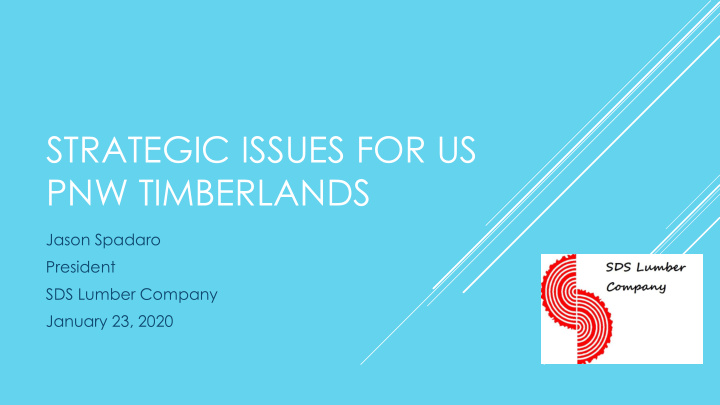



STRATEGIC ISSUES FOR US PNW TIMBERLANDS Jason Spadaro President SDS Lumber Company January 23, 2020
SDS COMPANIES SDS Lumber Company Lumber ▪ Plywood ▪ Energy ▪ Chipping ▪ Marine Transport ▪ Forest Management ▪ Logging/Trucking ▪
SDS COMPANIES Stevenson Land Company 105,000 acres timberland, Oregon & Washington ▪ Broughton Lumber Company 25,000 acres timberland ▪ Mid – Columbia Gorge Transition zone diversity Non-declining flow USFWS Safe Harbor Agreement
THREATS & OPPORTUNITIES IN TIMBERLAND? Positives Fundamentals of timberland ownership generally sound Demand for fiber Demand for timberland Markets for products
Concerns: Workforce Foresters Contractors Industry Manufacturing Capacity Headwinds Rising costs Tax environment Regulatory environment Workforce laborers Technicians Localized fiber supply constraints
Concerns (cont’d) Continued consolidation of manufacturing capacity for survival will have implications for timberland owners Regulatory Environment Herbicides Endangered species – aquatic & upland Unstable slopes State Capital Gains tax Carbon pricing Regulatory set asides & loss of forestry tools = Loss of productive lands
OREGON & WASHINGTON REGULATORY ENVIRONMENTS IN COMPARISON Oregon The land of Initiatives Stream Buffers Herbicides Unstable slopes Board of Forestry Cap & Trade 2019 Cap & Trade 2020
Oregon (cont’d) Significant uncertainty Costly, time & energy consuming battles on the horizon High risk of significant impacts to productive land base & timberland value Approaches to these regulatory risks can be divisive Oregon industry must remain unified in dealing with these risks
Washington History in Washington Timber Fish & Wildlife Agreement (1986) Forest & Fish Agreement & HCP (2006) Narrowing of issues Political capital Platform for cooperative, non-regulatory solutions
Washington (cont’d) Carbon approaches in WA Cap & Trade initiative rejected by voters Carbon Tax proposals Forest industry proposal HB 2528/SB 6355 Recognition that the forestry and wood products industry are net sequesters of carbon Forestry and wood products must be considered as an integrated system The manufacture and use of wood products (stored carbon) is an essential element Forestry and wood products are part of a sensible, natural carbon solution. Grow more wood, Use more wood.
CONCLUSION Significant regulatory/political and tax risks exist throughout the PNW for the forest industry Diplomacy & cooperative solutions are more durable The forest industry is the only industry with an opportunity to claim the re-frame the discussion on carbon Re-defining the carbon issue, is an opportunity for our industry to offer solutions and lessen political and regulatory risks
Recommend
More recommend